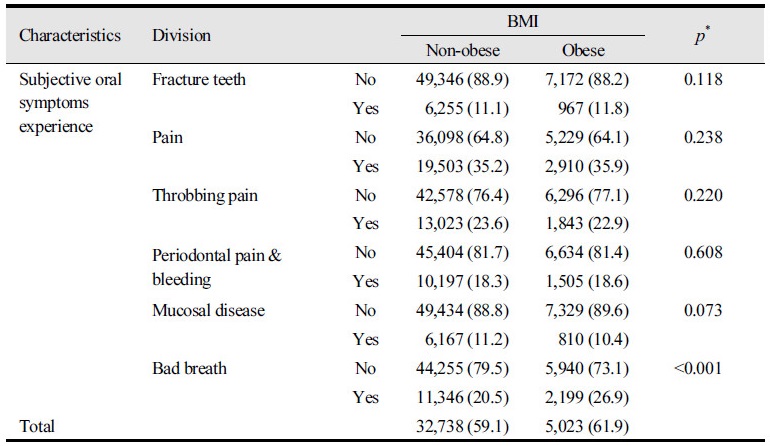Abstract
The purpose of this study is to identify the associated factors with subjective oral symptoms experience of obesity adolescents. The study subjects were targeting 8,139 obesity adolescents and 55,601 non-Obesity adolescents who completed 2016 Korean Youth Risk Behavior Web-based survey. Dependent variables were subjective oral symptoms experiences of fracture teeth, pain, throbbing pain, periodontal pain & bleeding, mucosal disease and bad breath. Independent variables were demographic characteristics of the subjects, oral health behaviors, health behaviors and eating habits. Obesity adolescents were 12.8% with 61.9% subjective oral symptoms experience. Regarding the related factors of subjective oral symptoms experience of obesity adolescents, the factors were identified to be significantly higher in high school (OR=1.72) compared to middle school, learning achievement was higher in middle (OR=1.09) and lower (OR=1.31) compared to high, economic status was higher in lower (OR=1.09) compared to high, sealant experience (OR=1.10) and scaling experiences (OR=1.12) responded no were higher compared to responded yes, smoking experiences responded yes(OR=1.08) were higher compared to responded no, sweet drink (OR=1.14) and fastfood (OR=1.13) consumption were higher in consumption compared to non-consumption and females (OR=0.46) were higher than males. Oral symptoms experience were lower that father and mother's level of education were under high school graduation (OR=0.86) compared to unknown, economic status was in case of middle (OR=0.93) compared to high, tooth brushing was lower in under 1 time (OR=0.76), 2 times (OR=0.61) compared to more than 3 times, vigorous physical activities responded no (OR=0.75) were lower, compared to yes, vegetable consumption was lower in non-consumption (OR=0.68) compared to consumption. Subjective oral symptoms experiences were identified higher in obesity adolescents than non-obesity adolescents. It would be useful to use the results of this study to reduce oral symptoms and necessary to develop a program system considering characteristics of obesity adolescents.
Figures & Tables

Table 1. Subjective oral symptoms experience


